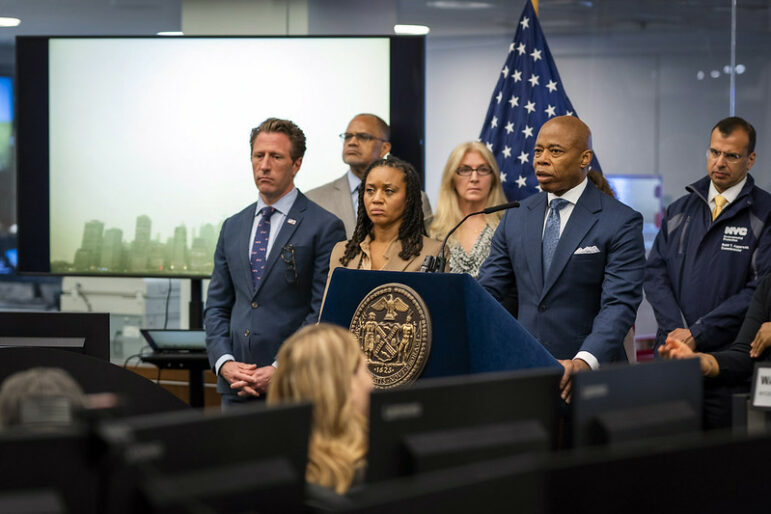“In fairness, this was an unprecedented challenge the city agencies had not ever confronted before,” said Councilmember Gale Brewer. “Some would say it was, however, foreseeable. For years scientists have warned us that rising global temperatures will lead to change in weather patterns, climate disasters, and direct harms to our health.”

Ed Reed/Mayoral Photography Office
Eric Adams and administration officials at a press conference about the wildfire smoke on June 7.During an oversight hearing on Wednesday, city officials defended their response to last month’s air quality emergency, when smoke from wildfires in Canada made New York City, briefly, among the most polluted cities in the world.
As smoke infiltrated the city in early June, some criticized the administration for not acting quickly enough to inform New Yorkers and advise them on what protocols to take. It wasn’t until the morning of Wednesday, June 7—after the skies had eerily turned orange and the air quality index climbed to a level considered “very unhealthy”—that Mayor Eric Adams held a press conference to address the crisis.
The City Council hearing, hosted jointly by three committees, presented an opportunity for councilmembers to press city officials from NYC Emergency Management, the Department of Health and Mental Hygiene, and the Department of Environmental Protection (DEP), on how they handled communications and decision making in response to the deteriorating air quality caused by Canadian wildfires.
Similar to flash flooding in incidents like Hurricane Ida, the smog was among the latest climate change impacts that have forced the city to rethink and revise its emergency response plans.
“In fairness, this was an unprecedented challenge the city agencies had not ever confronted before,” said Councilmember Gale Brewer, chair of the Committee on Oversight and Investigations. “Some would say it was, however, foreseeable. For years scientists have warned us that rising global temperatures will lead to change in weather patterns, climate disasters, and direct harms to our health.”
During the hearing, city agency officials emphasized that they did the best they could given the information they had on hand from the state’s Department of Conservation (DEC), which is responsible for monitoring air quality and issuing forecasts for New York.
Zachary Iscol, commissioner for NYC Emergency Management, said his team and agency partners began messaging warnings and guidance to New Yorkers starting on June 1 through Notify NYC, the city’s emergency notification system, and other channels. The city agency issued 11 Notify NYC alerts total.
The city issues air quality alerts through Notify NYC when the air quality index surpasses 100. Over 1 million people are signed up to get those alerts.
According to Iscol, DEC’s forecast for June 6 and 7, when the air quality was at its worst, was at a level that’s considered “unhealthy for sensitive groups,” which impacted how the agency responded.
“We didn’t have a forecast telling us that we were going to hit hazardous levels,” said Iscol. “As soon as we did, the day that the mayor held the first press conference, was the day that we had the first indicator of hazardous levels of air quality.”
Iscol touted Emergency Management’s “robust communications strategy,” pointing to interagency collaboration and outreach to local nonprofits and elected officials as examples of how they got the word out. “We do a lot more than just Notify NYC,” he said.
Corinne Schiff, deputy commissioner at the Department of Health and Mental Hygiene, was also proud of the work her department did to issue guidance by leveraging social media, and their network of community based organizations and health care providers.
But some councilmembers thought the administration could have done more to prepare New Yorkers for the smoky skies. In a heated exchange between Iscol and Public Advocate Jumaane Williams, Williams criticized the administration’s communication strategy, saying the mayor spoke up too late and that officials didn’t do enough to prime New Yorkers of the looming crisis.
“[The public] had no idea that there was a problem until the sky turned orange,” he said.
Councilmember Lincoln Restler, who represents neighborhoods in north Brooklyn, said the administration failed to protect unhoused New Yorkers in particular.
As the air quality reached hazardous levels that Wednesday, Restler called on the administration to issue a “Code Red”—an approach the city utilizes during periods of extreme heat—to allow those at risk to more easily access shelter.
“These are people who have chronic health conditions,” he said. “And yet we did nothing for them.”
As the crisis was unfolding, the Department of Social Services (DSS) deployed homeless outreach teams across the city who distributed masks and water and encouraged people to move indoors, the agency told City Limits at the time.
Despite the push back, Iscol stood his ground, reiterating that the city did the best it could given the circumstances.
“We can never do enough to make sure we’re educating New Yorkers so that they have the information they need to deal with extreme weather events,” he said. “But given this was an unprecedented event…I don’t fault us for not having done that before we knew what we were going to be dealing with.”








